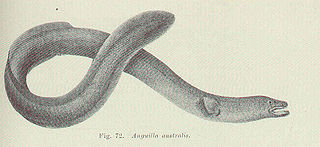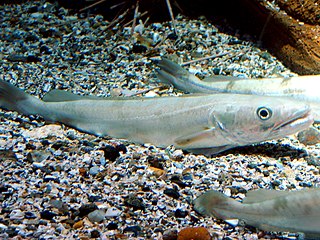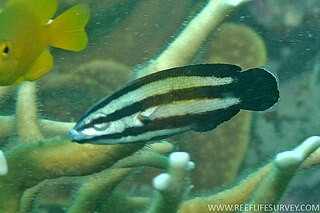The term hake refers to fish in the:

The Merlucciidae are a family of cod-like fish, including most hakes. They are native to cold water in the Atlantic and Pacific Oceans, and typically are found at depths greater than 50 m (160 ft) in subtropical, temperate, sub-Arctic or sub-Antarctic regions.

The forest raven, also commonly known as the Tasmanian raven, is a passerine bird in the family Corvidae native to Tasmania and parts of southern Victoria, such as Wilsons Promontory and Portland. Populations are also found in parts of New South Wales, including Dorrigo and Armidale. Measuring 50–53 cm (20–21 in) in length, it has all-black plumage, beak and legs. As with the other two species of raven in Australia, its black feathers have grey bases. Adults have white irises; younger birds have dark brown and then hazel irises with an inner blue rim. New South Wales populations are recognised as a separate subspecies C. tasmanicus boreus, but appear to be nested within the Tasmanian subspecies genetically.

The short-finned eel, also known as the shortfin eel, is one of the 15 species of eel in the family Anguillidae. It is native to the lakes, dams and coastal rivers of south-eastern Australia, New Zealand, and much of the South Pacific, including New Caledonia, Norfolk Island, Lord Howe Island, Tahiti, and Fiji.

The North Pacific hake, Pacific hake, Pacific whiting, or jack salmon is a ray-finned fish in the genus Merluccius, found in the northeast Pacific Ocean from northern Vancouver Island to the northern part of the Gulf of California. It is a silver-gray fish with black speckling, growing to a length of 90 cm (3 ft). It is a migratory offshore fish and undergoes a daily vertical migration from the surface to the seabed at depths down to about 1,000 m (3,300 ft). It is the object of an important commercial fishery off the West Coast of the United States, and annual quotas are used to prevent overfishing.
The scaly dragonfish or boa dragonfish, is a medium-sized abyssal barbeled dragonfish of the family Stomiidae. It is found at great depths worldwide in tropical to temperate oceans but is absent from the northern Pacific and northwest Atlantic Oceans.

The silver hake, Atlantic hake, or New England hake is a merluccid hake of the genus Merluccius, found in the northwest Atlantic Ocean. It is highly predatory and typically feeds on fish and crustaceans.

The Australian angelshark is a species of angelshark, family Squatinidae, found in the subtropical waters of southern Australia from Western Australia to New South Wales between latitudes 18°S and 41°S, at depths down to 255 m (840 ft). Its length is up to 1.52 m (5 ft). Reproduction is ovoviviparous, with up to 20 pups in a litter.
Sepia australis, the southern cuttlefish, is a species of cuttlefish which is found in the eastern South Atlantic Ocean and the western Indian Ocean off the coasts of Southern Africa, possibly extending into the waters off East Africa.

Merluccius is a genus of merluccid hakes from the Atlantic and Pacific Oceans, where mainly found relatively deep.

Merluccius merluccius, the European hake, is a merluccid hake of the genus Merluccius. Other vernacular names include Cornish salmon and herring hake. It is a predatory species which was often netted alongside one of its favoured prey, the Atlantic herring, thus the latter common name. It is found in the eastern Atlantic from the Norway and Iceland south to Mauritania and into the Mediterranean Sea. It is an important species in European fisheries and is heavily exploited with some populations thought to be being fished unsustainably.

Merluccius gayi is a merluccid hake of the genus Merluccius, with two subspecies, the South Pacific hake or Chilean common hake and the Peruvian hake, found in the south-western Pacific Ocean, along the coast of South America, from Peru to the Chilean coasts north to the Chiloé Archipelago. During the Southern Hemisphere summer, it migrates southwards in shallow waters, while in the winter, it lives more to the north, in far deeper waters.

Merluccius capensis is a ray-finned fish in the genus Merluccius, found in the south-eastern Atlantic Ocean, along the coast of South Africa. It is a long, lean fish with a large head, similar in appearance to the European hake and the deep-water Cape hake. By day, it lives close to the bottom on the continental shelf and upper slope at depths not usually exceeding 400 m (1,300 ft); it makes a large, daily vertical migration rising at night to feed in the nectonic zone, and it also migrates southwards in spring and northwards in autumn. It is an important commercial fish species in southern Africa.

The Argentine hake is a merluccid hake of the genus Merluccius, found in the southwestern Atlantic Ocean, along the coast of Argentina, and Uruguay. This fish was described by an Argentine ichthyologist, Tomás Marini in 1933.
The Panama hake, also known as the dwarf hake, is a merluccid hake of the genus Merluccius, found off the west coast of the Americas from Del Mar, California, to Ensenada de Tumaco, Colombia.
Southern hake is a common name for several fishes and may refer to:
Merluccius australis, the Southern hake, is a species of fish from the family Merlucciidae, the true hakes. It is found in the southern Pacific and Atlantic Oceans with two disjunct populations, one around southern South America and the other in the waters around New Zealand.
Merluccius patagonicus, the Patagonian hake, is a species of fish from the family Merlucciidae from the western South Atlantic which was described in 2003. However some authorities consider the distinguishing features of M. patagonicus to be within the range of variability for M. hubbsi and that M. patagonicus is therefore a synonym of M. hubbsi.
Merluccius polli, the Benguela hake, is a species of fish from the family Merlucciidae, the true hakes. It is found in the tropical waters of the eastern Atlantic Ocean off the west coast of Africa.

Labropsis australis, the southern tubelip, is a species of marine ray-finned fish from the family Labridae, the wrasses. This species occurs in the south western Pacific Ocean from the Solomon Islands, Samoa, Vanuatu, Fiji, the Loyalty Islands, Tonga and the Great Barrier Reef. It is found in areas with heavy growth of corals including reefs, lagoons, passages and slopes. The adults feed on polyps in the coral while the juveniles feed on ectoparasites, and maybe mucus, on other reef fishes.










